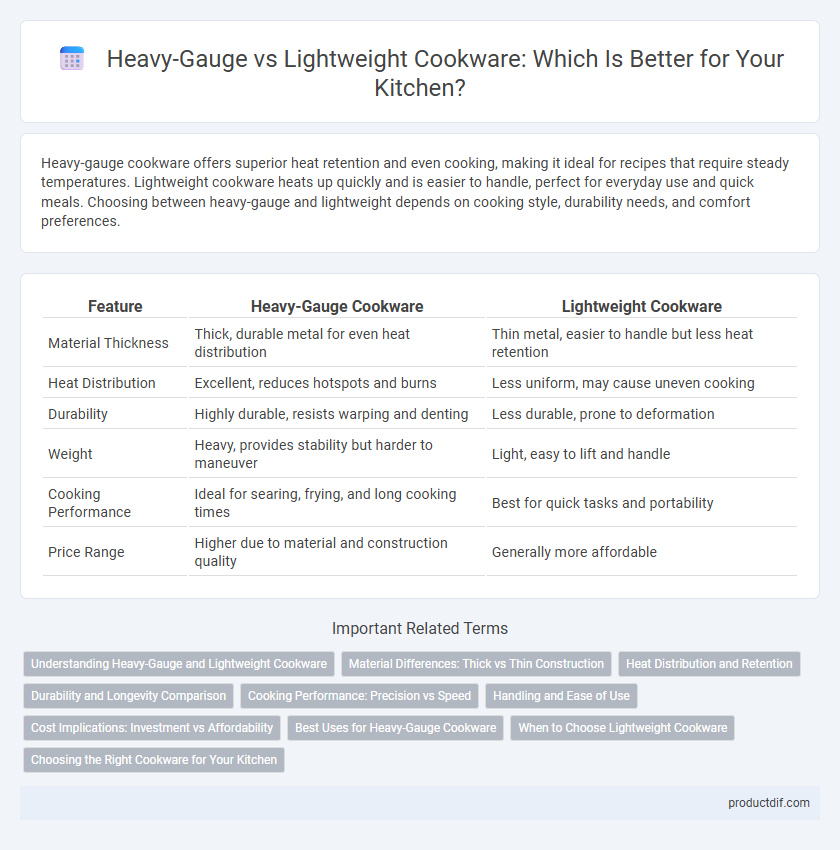Heavy-gauge cookware offers superior heat retention and even cooking, making it ideal for recipes that require steady temperatures. Lightweight cookware heats up quickly and is easier to handle, perfect for everyday use and quick meals. Choosing between heavy-gauge and lightweight depends on cooking style, durability needs, and comfort preferences.
Table of Comparison
| Feature | Heavy-Gauge Cookware | Lightweight Cookware |
|---|---|---|
| Material Thickness | Thick, durable metal for even heat distribution | Thin metal, easier to handle but less heat retention |
| Heat Distribution | Excellent, reduces hotspots and burns | Less uniform, may cause uneven cooking |
| Durability | Highly durable, resists warping and denting | Less durable, prone to deformation |
| Weight | Heavy, provides stability but harder to maneuver | Light, easy to lift and handle |
| Cooking Performance | Ideal for searing, frying, and long cooking times | Best for quick tasks and portability |
| Price Range | Higher due to material and construction quality | Generally more affordable |
Understanding Heavy-Gauge and Lightweight Cookware
Heavy-gauge cookware features thicker metal construction, typically ranging from 3mm to 5mm, which ensures superior heat retention and even cooking performance, making it ideal for searing and slow cooking. Lightweight cookware, often thinner at 1mm to 2mm, heats up quickly and offers easier maneuverability, perfect for quick tasks and frequent stirring. Choosing between heavy-gauge and lightweight cookware depends on cooking style, with heavy-gauge favored for durability and temperature control, while lightweight is preferred for speed and ease of use.
Material Differences: Thick vs Thin Construction
Heavy-gauge cookware features thick construction typically made from materials like stainless steel or cast iron, offering superior heat retention and even distribution. Lightweight cookware, often crafted from aluminum or thin stainless steel, heats up quickly but may have hot spots and less durability. Choosing between thick and thin construction impacts cooking performance, longevity, and heat control significantly.
Heat Distribution and Retention
Heavy-gauge cookware offers superior heat distribution and retention due to its thick metal construction, ensuring even cooking and minimizing hot spots. Lightweight cookware heats up quickly but tends to lose heat faster, causing inconsistent temperatures during cooking. Choosing heavy-gauge pans enhances control over cooking processes, especially for dishes requiring steady, maintained heat.
Durability and Longevity Comparison
Heavy-gauge cookware, typically made from thicker materials like stainless steel or cast iron, offers superior durability and extends the lifespan due to its resistance to warping and denting. Lightweight cookware, often aluminum or thin stainless steel, may heat quickly but tends to wear out faster, showing signs of warping or coating degradation over time. Choosing heavy-gauge cookware ensures prolonged performance and reliability in busy kitchens.
Cooking Performance: Precision vs Speed
Heavy-gauge cookware provides superior heat retention and even distribution, enabling precise temperature control essential for delicate cooking tasks like simmering sauces and searing meats. Lightweight cookware heats up quickly, offering faster cooking times but often at the expense of uniform heat, which can lead to hot spots and unevenly cooked food. Choosing between these options depends on whether cooking precision or speed is the priority for specific culinary needs.
Handling and Ease of Use
Heavy-gauge cookware offers superior heat retention and durability but can be cumbersome and tiring to handle during extended cooking sessions. Lightweight cookware provides enhanced maneuverability and easier lifting, ideal for quick flipping and tossing, especially in fast-paced kitchens. Choosing between heavy-gauge and lightweight depends on balancing stability with ease of use to match specific cooking techniques and user preferences.
Cost Implications: Investment vs Affordability
Heavy-gauge cookware, made from thick materials like stainless steel or cast iron, demands a higher initial investment due to superior durability and heat retention, often leading to long-term savings through reduced replacement needs. Lightweight cookware, typically crafted from aluminum or thin stainless steel, offers affordability upfront but may require more frequent replacement due to warping or wear, increasing overall costs over time. Choosing between heavy-gauge and lightweight options depends on balancing budget constraints with the value placed on cookware longevity and cooking performance.
Best Uses for Heavy-Gauge Cookware
Heavy-gauge cookware offers superior heat retention and even distribution, making it ideal for searing steaks, slow-cooking stews, and frying foods at consistent temperatures. Its durability withstands frequent use and high temperatures, perfect for professional kitchens or avid home cooks who require long-lasting performance. While heavier to handle, heavy-gauge pots and pans excel in cooking methods that benefit from steady, controlled heat.
When to Choose Lightweight Cookware
Lightweight cookware is ideal for quick cooking tasks and recipes requiring frequent stirring or tossing, such as sauteing vegetables or making delicate sauces. It offers superior heat responsiveness and ease of maneuverability, making it perfect for home cooks who prioritize speed and convenience. When portability and effortless handling are essential, lightweight materials like aluminum or stainless steel provide optimal performance without the bulk.
Choosing the Right Cookware for Your Kitchen
Heavy-gauge cookware offers superior heat retention and durability, making it ideal for searing and slow cooking, while lightweight options provide better maneuverability and faster heating, perfect for everyday tasks and quick meals. Selecting the right cookware depends on your cooking style, kitchen space, and maintenance preferences, with heavy-gauge pans often favored by professional chefs for their even heat distribution. Prioritize materials like stainless steel or anodized aluminum for heavy-gauge sets, and consider nonstick or aluminum alloys for lightweight versatility and ease of use.
Heavy-Gauge vs Lightweight Infographic

 productdif.com
productdif.com